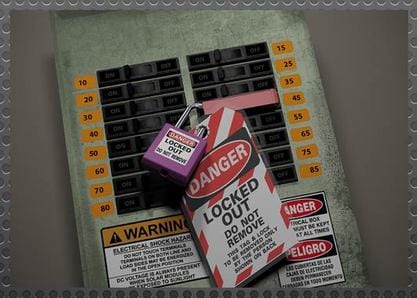- About Us
- Our Services
- Training Expertise
- Crisis Management for Business & Industry
- DOT PHMSA ALERT Rail Car Training
- Emergency Management
- Environmental & HAZMAT
- First Response & HAZWOPER
- Maritime Security
- OSHA Training/Confined Space
- RDPC
- Safer News Gathering
- Safer Ohio Schools Using Threat Assessment Management
- School Safety & Security
- Workplace Violence Prevention
- Courses
- Our Clients
- Media
D Times 3: Safer Powered Equipment Practices

Electrical hazards in the workplace are the subject of a recent article at OHS Online. Contributor Tony Quebbemann underscores the importance of consistent Lock Out/Tag Out procedures, describes how ground fault circuit interrupters can save lives and emphasizes that clear and comprehensive training is essential.
Naturally, we concur with all parts of the OHS Online piece, and believe the latter point – the necessity for training – is too often overlooked. A customized training program will evaluate and address each specific electrical hazard at all of your facilities. And it’s true that Lock Out/Tag Out is often the core of electric safety training, as it well should be. As the article in reference points out, failure to control hazardous energy is among the most frequent of OSHA citations and overlooked Lock Out/Tag Out procedures are surely an often cause of such fines.
Locking an electrical device’s power switch when the device is unused or out of service has been a standard safety step for decades.
Preventing the switch from being thrown without a key to release an attached lock is a typical and reliable means of keeping a machine from starting during maintenance or cleaning. But simply disabling (or ‘defeating’) the power controls is not enough of a measure to truly allow safe work on many machines. Some devices store energy when not in use, and it is possible that these machines could release that energy unexpectedly. This may happen even if the power controls are defeated, and even if the energy stored is not electrical in nature. For example, air compressors use electricity to compress oxygen and regulate its flow from the storage vessel. If the compressor is being serviced, simply locking the power switch is not a completely reliable way to keep the compressor from suddenly releasing its air volume. The compressor’s air tank should be bled before repairing, cleaning, or even relocating the machine. This step is called de-energizing and it applies to any equipment that stores any kind of energy with the potential to cause harm if that energy is inadvertently released.
Another important step that goes along with Lock Out/Tag Out, and is often overlooked, is a disconnection, or completely eliminating the electrical source from a powered device. As Quebbemann says, this process “can be time-consuming. This process can include donning cumbersome personal protective equipment and opening the switch to manually probe wires using a volt meter to confirm zero power.” But even steps like that should not be a deterrent from establishing absolute certainty that no voltage can reach an electrical device that is being taken offline. If powered equipment is due for repair, or scheduled to be out of service for any reason, schedule enough time in the day to allow for every step needed to make that device truly inert – the three Ds: De-energize, Disconnect, and Defeat (or Lock Out/Tag Out).
Of course, there are many other aspects of safe control of powered equipment. Learning OSHA regulations is crucial, particularly for specific job descriptions. And making certain that the environment where powered machines are being used is conducive to safe operation is another facet of this topic that is too often overlooked. Only a thorough training program from experienced instructional designers can assure that your associates are using powered devices as safely as possible. Contact Findlay All Hazards today to discuss a customized, on-site safe work program for your organization.
